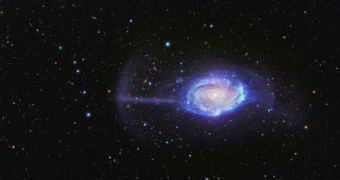Those worried that they have an appetite too big for their own good need no longer sweat over what constitutes a decent portion. As it turns out, it's the Umbrella Galaxy that should start paying closer attention to the size of its meals.
Not to beat about the bush, researchers with the Australian Astronomical Observatory have found that the Umbrella Galaxy, which sits at a distance of about 62 million light-years from Earth, is a cosmic cannibal through and through.
Besides, the scientists say that, according to their investigations into the matter at hand, it is a fairly messy eater as well, hence the fact that so-called space crumbs are scattered all around it.
In a press release on the matter at hand, Australian Astronomical Observatory scientists explain that, when the Umbrella Galaxy was first discovered, astronomers noticed an odd parasol-like structure in its proximity.
At that time, it was assumed that this parasol was an accompanying dwarf galaxy. However, the umbrella-like structure was later revealed to be stars and debris, i.e. space crumbs, resulting from the cannibal galaxy's feeding habits.
Data obtained with the help of the Subaru and Keck telescopes in Hawaii indicates that, rather than having formed in the aftermath of several meals, the Umbrella Galaxy's parasol is the result of a single but pretty impressive meal.
This theory was first brought forth by a team led by David Martínez-Delgado of University of Heidelberg back in 2010, and has now been confirmed by Australian Astronomical Observatory scientists.
“Through new techniques we have been able to measure the movements of the stars in the very distant, very faint, stellar stream in the Umbrella. This allows us to reconstruct the history of the system, which we couldn’t before,” says study leader Dr. Caroline Foster.
“In turn that means we can get a handle on how often these 'minor mergers' – an important way that galaxies grow – actually occur,” adds Dr Aaron Romanowsky with the San José State University and University of California Observatories.
Interestingly enough, astronomers explain that, according to evidence at hand, our Milky Way, which happens to be a twin of the Umbrella Galaxy, is no stranger to cannibalism either. On the contrary, evidence indicates that the Milky Way has also acquired stars from other, smaller galaxies over the years.
Researchers expect that, by studying the feeding habits of our galaxy and that of the Umbrella Galaxy, they will be able to gain a better understanding of how the universe has changed throughout its history.

 14 DAY TRIAL //
14 DAY TRIAL //